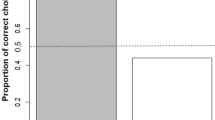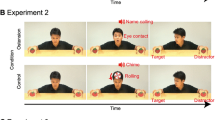Abstract
Recent research has shown that domestic dogs are particularly good at determining the focus of human attention, often outperforming chimpanzees and hand-reared wolves. It has been suggested that the close evolutionary relationship between humans and dogs has led to the development of this ability; however, very few other domestic species have been studied. We tested the ability of 36 domestic horses to discriminate between an attentive and inattentive person in determining whom to approach for food. The cues provided were body orientation, head orientation or whether the experimenters’ eyes were open or closed. A fourth, mixed condition was included where the attentive person stood with their body facing away from the subjects but their head turned towards the subject while the inattentive person stood with their body facing the subject but their head turned away. Horses chose the attentive person significantly more often using the body cue, head cue, and eye cue but not the mixed cue. This result suggests that domestic horses are highly sensitive to human attentional cues, including gaze. The possible role of evolutionary and environmental factors in the development of this ability is discussed.




Similar content being viewed by others
References
Agnetta B, Hare B, Tomasello M (2000) Cues to food location that domestic dogs (Canis familiaris) of different ages do and do not use. Anim Cogn 3:107–112
Andersen IL, Naevdal E, Boe KE, Bakken M (2006) The significance of theories in behavioural ecology for solving problems in applied ethology—possibilities and limitations. Appl Anim Behav Sci 97:85–104
Barth J, Reaux JE, Povinelli DJ (2005) Chimpanzees’ (Pan troglodytes) use of gaze cues in object-choice tasks: different methods yield different results. Anim Cogn 8:84–92
Bartosova J, Dvorakova R, Vancatova M, Svobodova I (2008) Comprehension of human pointing gesture in domestic horses: effect of training method. In: Krueger K (ed) International Equine Science Meeting, University of Regensburg, Germany
Brauer J, Call J, Tomasello M (2004) Visual perspective taking in dogs (Canis familiaris) in the presence of barriers. Appl Anim Behav Sci 88:299–317
Bulloch MJ, Boysen ST, Furlong EE (2008) Visual attention and its relation to knowledge states in chimpanzees, Pan troglodytes. Anim Behav 76:1147–1155
Call J, Brauer J, Kaminski J, Tomasello M (2003) Domestic dogs (Canis familiaris) are sensitive to the attentional state of humans. J Comp Psychol 117:257–263
Clutton-Brock J (1999) A natural history of domesticated animals. Cambridge University Press, London
Cooper JJ (2007) Equine learning behaviour: common knowledge and systematic research. Behav Processes 76:24–26
Ferrari PF, Kohler E, Fogassi L, Gallese V (2000) The ability to follow eye gaze and its emergence during development in macaque monkeys. Proc Natl Acad Sci USA 97:13997–14002
Flombaum JI, Santos LR (2005) Rhesus monkeys attribute perceptions to others. Curr Biol 15:447–452
Gácsi M, Miklósi A, Varga O, Topál J, Csányi V (2004) Are readers of our face readers of our minds? Dogs (Canis familiaris) show situation-dependent recognition of human’s attention. Anim Cogn 7:144–153
Gácsi M, Kara E, Belényi B, Topál J, Miklósi Á (2008) The effect of development and individual differences in pointing comprehension of dogs. Anim Cogn 12:471–479. doi:10.1007/s10071-008-0208-6
Giret N, Miklósi Á, Kreutzer M, Bovet D (2008) Use of experimenter-given cues by African gray parrots (Psittacus erithacus). Anim Cogn 12:1–10. doi:10.1007/s10071-008-0163-2
Goodwin D (1999) The importance of ethology in understanding the behaviour of the horse. Equine Vet J Suppl 28:15–19
Goodwin D (2002) Horse behaviour: evolution, domestication and feralisation. In: Waran N (ed) The welfare of horses. Kluwer, Dordrecht, pp 19–44
Hare B, Tomasello M (2004) Chimpanzees are more skilful in competitive than in cooperative cognitive tasks. Anim Behav 68:571–581
Hare B, Call J, Agnetta B, Tomasello M (2000) Chimpanzees know what conspecifics do and do not see. Anim Behav 59:771–785
Hare B, Call J, Tomasello M (2001) Do chimpanzees know what conspecifics know? Anim Behav 61:139–151
Hare B, Brown M, Williamson C, Tomasello M (2002) The domestication of social cognition in dogs. Science 298:1634–1636
Harman AM, Moore S, Hoskins R, Keller P (1999) Horse vision and an explanation for the visual behaviour originally explained by the ‘ramp retina’. Equine Vet J 31:384–390
Hattori Y, Kuroshima H, Fujita K (2007) I know you are not looking at me: capuchin monkeys’ (Cebus apella) sensitivity to human attentional states. Anim Cogn 10:141–148
Hostetter AB, Cantero M, Hopkins WD (2001) Differential use of vocal and gestural communication by chimpanzees (Pan troglodytes) in response to the attentional status of a human (Homo sapiens). J Comp Psychol 115:337–343
Hostetter AB, Russel JL, Freeman H, Hopkins WD (2007) Now you see me now you don’t: evidence that chimpanzees understand the role of the eyes in attention. Anim Cogn 10:55–62
Itakura S, Bryan A, Hare B, Tomasello M (1999) Chimpanzee use of human and conspecific social cues to locate hidden food. Dev Sci 2:448–456
Jensen P (2002) The ethology of domestic animals: an introductory text. CABI, Wallingford
Kaminski J, Call J, Tomasello M (2004) Body orientation and face orientation: two factors controlling apes’ begging behavior from humans. Anim Cogn 7:216–223
Kaminski J, Riedel J, Call J, Tomasello M (2005) Domestic goats, Capra hircus, follow gaze direction and use social cues in an object choice task. Anim Behav 69:11–18
Leavens DA, Hostetter AB, Wesley MJ, Hopkins WD (2004) Tactical use of unimodal and bimodal communication by chimpanzees, Pan troglodytes. Anim Behav 67:467–476
Maros K, Gácsi M, Miklósi Á (2008) Comprehension of human pointing gestures in horses (Equus caballus). Anim Cogn 11:457–466
McComb K, Moss C, Sayialel S, Baker L (2000) Unusually extensive networks of vocal recognition in African elephants. Anim Behav 59:1103–1109
McComb K, Moss C, Durant SM, Baker L, Sayialel S (2001) Matriarchs as repositories of social knowledge in African elephants. Science 292:491–494
McKinley J, Sambrook TD (2000) Use of human-given cues by domestic dogs (Canis familiaris) and horses (Equus caballus). Anim Cogn 3:13–22
Miklósi A, Polgárdi R, Topál J, Csányi V (1998) Use of experimenter-given cues in dogs. Anim Cogn 1:113–122
Miklósi A, Kubinyi E, Topál J, Gácsi M, Virányi Z, Csányi V (2003) A simple reason for a big difference: wolves do not look back at humans, but dogs do. Curr Biol 13:763–766
Miklósi A, Pongrácz N, Lakatos G, Topál J, Csányi V (2005) A comparative study of the use of visual communicative signals in interactions between dogs (Canis familiaris) and humans and cats (Felis catus) and humans. J Comp Psychol 119:179–186
Outram AK, Stear NA, Bendrey R, Olsen S, Kasparov A, Zaibert V, Thorpe N, Evershed RP (2009) The earliest horse harnessing and milking. Science 323:1332–1335
Pack AA, Herman LM (2004) Bottlenosed dolphins (Tursiops truncatus) comprehend the referent of both static and dynamic human gazing and pointing in an object-choice task. J Comp Psychol 118:160–171
Pfungst O (1965) Clever Hans (the horse of Mr. von Osten). In: Rosenthal R (ed) Holst (Rinehardt & Winston), New York
Povinelli DJ, Eddy TJ (1996) What young chimpanzees know about seeing. Monogr Soc Res Child Dev 61:153–191
Proops L, McComb K, Reby D (2009) Cross-modal individual recognition in domestic horses (Equus caballus). Proc Natl Acad Sci USA 106:947–951
Riedel J, Schumann K, Kaminski J, Call J, Tomasello M (2008) The early ontogeny of human-dog communication. Anim Behav 75:1003–1014
Scheumann M, Call J (2004) The use of experimenter-given cues by South African fur seals (Arctocephalus pusillus). Anim Cogn 7:224–230
Schloegl C, Kotrschal K, Bugnyar T (2008) Modifying the object-choice task: is the way you look important for ravens? Behav Processes 77:61–65
Schwab C, Huber L (2006) Obey or not obey? Dogs (Canis familiaris) behave differently in response to attentional states of their owners. J Comp Psychol 120:169–175
Shapiro AD, Janik VM, Slater PJB (2003) A gray seal’s (Halichoerus grypus) responses to experimenter-given pointing and directional cues. J Comp Psychol 117:355–362
Soproni K, Miklósi A, Topál J, Csányi V (2001) Comprehension of human communicative signs in pet dogs (Canis familiaris). J Comp Psychol 115:122–126
Soproni K, Miklósi A, Topál J, Csányi V (2002) Dogs’ (Canis familiaris) responsiveness to human pointing gestures. J Comp Psychol 116:27–34
Takimoto A, Fujita K (2008) Are horses (Equus caballus) sensitive to human attentional states? In: Krueger K (ed) International Equine Science Meeting, University of Regensburg, Germany
Timney B, Keil K (1992) Visual acuity in the horse. Vis Res 32:2289–2293
Tomasello M, Hare B, Lehmann H, Call J (2007) Reliance on head versus eyes in the gaze following of great apes and human infants: the cooperative eye hypothesis. J Hum Evol 52:314–320
Tschudin A, Call J, Dunbar RIM, Harris G, van der Elst C (2001) Comprehension of signs by dolphins (Tursiops truncatus). J Comp Psychol 115:100–105
Udell MAR, Dorey NR, Wynne CDL (2008) Wolves outperform dogs in following human social cues. Anim Behav 76:1767–1773
Vervill S, McDonnell S (2008) Equal outcomes with and without human-to-horse eye contact when catching horses and ponies in an open pasture. J Equine Vet Sci 28:309–312
Vick SJ, Anderson JR (2003) Use of human visual attention cues by olive baboons (Papio anubis) in a competitive task. J Comp Psychol 117:209–216
Virányi Z, Topál J, Gácsi M, Miklósi A, Csányi V (2004) Dogs respond appropriately to cues of humans’ attentional focus. Behav Processes 66:161–172
Virányi Z, Gácsi M, Kubinyi E, Topál J, Belényi B, Ujfalussy D, Miklósi Á (2008) Comprehension of human pointing gestures in young human-reared wolves (Canis lupus) and dogs (Canis familiaris). Anim Cogn 11:373–397
Waring G (2003) Horse behaviour, 2nd edn. Noyes & William Andrew, Norwich
Wells SM, Goldschmidt-Rothschild BV (1979) Social behavior and relationships in a herd of Camargue horses. Z Tierpsychol 49:363–380
Acknowledgments
We are grateful to the members of staff at The Sussex Horse Rescue Trust and the owners of the horses at the Woodingdean livery yard for their support and willingness to facilitate this project. We also thank Ben Colwell and Laura Hazelton who contributed to this study in the course of their final year undergraduate research projects and Graeme Shannon and James McMichen for their help with data collection. The study complies with the United Kingdom Home Office regulations concerning animal research and welfare as well as the University of Sussex regulations on the use of animals. This work is supported by a quota studentship from the BBSRC (to L.P., supervised by K.M.).
Author information
Authors and Affiliations
Corresponding author
Rights and permissions
About this article
Cite this article
Proops, L., McComb, K. Attributing attention: the use of human-given cues by domestic horses (Equus caballus). Anim Cogn 13, 197–205 (2010). https://doi.org/10.1007/s10071-009-0257-5
Received:
Revised:
Accepted:
Published:
Issue Date:
DOI: https://doi.org/10.1007/s10071-009-0257-5




